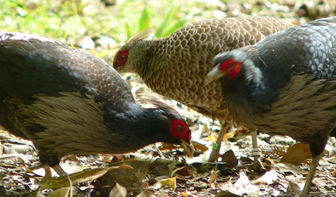Kalij Pheasant
The name is also spelt Kaleege in old texts, such as Game Birds of India and Asia by Frank Finn,

The Kalij Pheasant is classified as Least Concern. Does not qualify for a more at risk category. Widespread and abundant taxa are included in this category.
The Kalij Pheasant, Lophura leucomelanos, is a pheasant found in forests and thickets, especially in the Himalayan foothills, from the Indus River to western Thailand. It has also been introduced to Hawaii (though somewhat rare), where it is considered an invasive species because it consumes and disperses seeds of invasive plant species. Males are rather variable depending on the subspecies involved, but all have an at least partially glossy bluish-black plumage, while females are overall brownish. More
Kalij Pheasant: Six to nine cream eggs are laid in a shallow scrape lined with leaves and rubbish. Female incubates for 20 to 23 days. Male takes no part in nesting but may rejoin after chicks have left the nest. Foraging and Feeding Kalij Pheasant: Forages along roadsides, clearings, and in forests for seeds and insects. Vocalization Kalij Pheasant: Male has a crowing call and courtship call is a shrill pig-like squeal. More
Kalij Pheasant: Glossy blue-black overall, face has bright red wattles. Crest, breast, and sides have long white to gray-brown feathers. Feathers from mid-back to rump edged in white giving a scalloped appearance, tail is long and black. Female has brown crest and body. Juvenile is dark brown, head is rufous with dark ear coverts. Upperparts mottled brown, black, and rufous, underparts are lighter brown. More
Kalij Pheasant (Lophura leucomelanos) is a scarce resident in the hills of north and north east India. Size: 55-75 cm. More
Kalij Pheasants are generally forest dwelling birds found in the southern foothills of the Himalayas. The nine recognized subspecies range from Pakistan across northern India and Nepal. Some are found as far south as Bangladesh and Thailand. These birds have proven hardy and easily bred in captivity. Incubation lasts 20-22 days. The male takes no part in protecting the nest, but may rejoin the family after the chicks hatch. Chicks can fly within a few days. More
* Hawaiian Creatures - Kalij Pheasant - An article on this species which has been established in the Hawaiian Islands. * Kalij Pheasant - BirdLife species factsheet. * Kalij Pheasant - Mangoverde World Bird Guide Species Page; Photos & Sounds. * Kalij Pheasant - The Oriental Bird Club Image Database. More
The Kalij Pheasant is one of 12 game birds that were introduced into Hawai'i. Brought to the islands in 1962, this bird's population is rapidly increasing. The male and female Kalij differ considerably in looks. The male is quite striking and is mainly bluish black with white speckling on its lower back. The male has bright red around the eyes. The females, on the other hand, are fairly plain. They are a medium brown color with darker and lighter spots. More
The Kalij Pheasant, Lophura leucomelanos is a pheasant found all along the foothills of the Himalaya in a number of local populations with variations. They are also found (though somewhat rare) in the Islands of Hawaii. More
The Nepal Kalij Pheasant is a very finely marked bird which will become very trusting and adapts well to aviaries. They should be kept only as pairs, due to the fact that hens can become aggressive with other hens. They will eat layer pellets, grain, seeds, leaves and insects. Their laying season is usually starts mid April, with an incubation period of 25 days. They are in full color, and SOLD AS MALE/FEMALE PAIRS. They are from a 2009 hatch. More
subspecies of the Kalij Pheasant and others as subspecies of the Silver Pheasant. They have greyish legs as in the Kalij Pheasant, but their plumage is closer to that of some subspecies of the Silver Pheasant. More

Family : Phasianidae
Genus : Lophura
Species : leucomelanos
Authority : (Latham, 1790)
